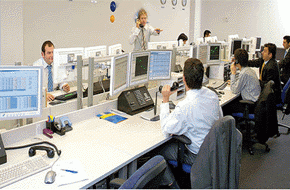

After what has been a terrible month for global equities, markets ended October in risk-on mode. US and European equity markets have risen strongly and US Treasury yields have moved higher. The USD has continued to push higher, helped by better than expected US data.
One of the hazards of writing this report before the US market close is that US equity markets can rapidly change direction in the last hour or two of trading, changing the narrative for the day (and rendering some of this commentary a bit dated). But as we write this, there is a decidedly risk-on tone to markets, with US equity indices posting impressive gains on the day (S&P500: +1.9%, NASDAQ: 2.8%). Tech stocks were given a boost by Facebook’s earnings report, released after the bell yesterday, which showed higher than expected earnings, and revenue growth close to expectations (although the company did note slow growth in user numbers). After disappointing revenue estimates from Amazon and Google, the Facebook results were probably a relief to the market. Apple reports its earnings tomorrow morning, after the market close.
Even after the strong gains overnight, it has been a tough month for global equity markets. The S&P500 is currently down 6% in October, NASDAQ 8.5%, Eurostoxx 6%, Nikkei 9%, and China’s CSI300 down 8%.
US Treasury yields moved higher overnight, mainly due to the improvement in risk sentiment, although another batch of strong US data assisted the moves. The US employment cost index showed a higher than expected increase in wages in Q3, bringing the annual rate of wage growth to 2.8% (up from 2.5% in 2017 and 2.2% in 2016). And ahead of non-farm payrolls on Friday night, the ADP employment index showed a larger than expected increase in jobs growth (although it has been a less reliable leading indicator of late). Finally, the Chicago PMI fell a little more than expected but remains at very healthy levels overall. The 10 year Treasury yield is up 2bps to 3.14% as we write, and 8bps higher on the month.
The stronger US data helped the USD move higher again overnight, with both the DXY index (+0.2%) and Bloomberg DXY (+0.3%) making fresh highs. The various USD indices rose by 1.5% to 2.5% in October. The relative strength of the US economy, set against continued gradual slowing elsewhere, has helped support the USD. The EUR is currently challenging the 1.13 level (the lows set in August) and is down 0.3% on the day. European CPI released overnight met expectations and had little impact on the EUR. European core inflation, at 1.1%, remains a long way below the ECB’s target.
In China, the Politburo, chaired by President Xi, announced that preemptive measures were required to combat downward pressure on the economy. Analysts expect further loosening in monetary and fiscal policy by the authorities. Yesterday, the official manufacturing PMI slowed by more than expected, to 50.2, while the non-manufacturing PMI also slowed to 53.9. The CNY continues to hover just below the psychologically important 7.0 mark against the USD, and there were signs of the Chinese authorities taking steps to tighten liquidity in the offshore CNH market (making it more expensive to short the CNH) by increasing bill sales.
The NZD and AUD are the two underperformers in the G10 universe over the past 24 hours, both down around 0.5%. Besides the broader backdrop of USD strength, the weakness in the AUD can be partly attributed to the downside surprise in Australian core inflation yesterday. The weighted median and trimmed mean measures came in at 1.7% and 1.8% respectively (vs. 1.9% expected), still some way below the mid-point of the RBA’s 2-3% inflation target range.
Yesterday’s ANZ business survey had little impact on the NZD nor the NZ rates market. The own-activity measure was little changed from last month, and while this continues to point to the risk of sub-trend growth, ‘hard’ NZ data continues to hold up at far better levels. There was another nudge higher in the inflation and pricing intention indicators, which point to CPI heading above the mid-point of the target range. NZ rates were between 1 to 4.5bps higher, with the curve steepening. The overnight move higher in US yields should see these moves extend a little further today. Meanwhile, the NZD is around 0.6520, close to where it started the week.
The ISM manufacturing survey is the focus tonight. The Bloomberg consensus expects a slight fall from 59.8 to 59, in line with some softness in the regional Fed surveys, although those levels would still be consistent with very strong growth in the US manufacturing sector. The BoE is also meeting, although the market does not expect any change in stance from the Bank until the uncertainty over Brexit is resolved.
Get our daily currency email by signing up here:
Daily exchange rates
Select chart tabs
BNZ Markets research is available here.

We welcome your comments below. If you are not already registered, please register to comment
Remember we welcome robust, respectful and insightful debate. We don't welcome abusive or defamatory comments and will de-register those repeatedly making such comments. Our current comment policy is here.